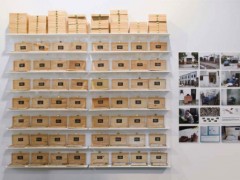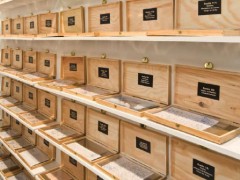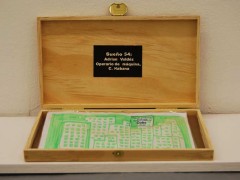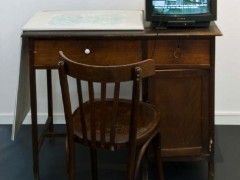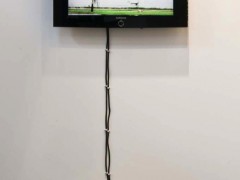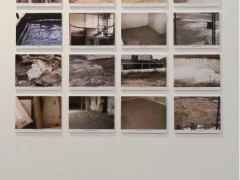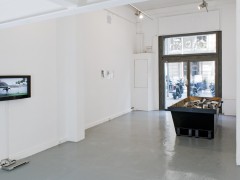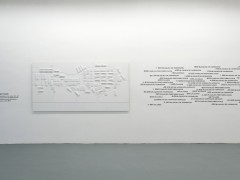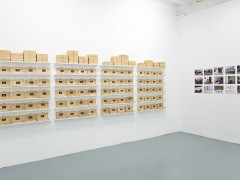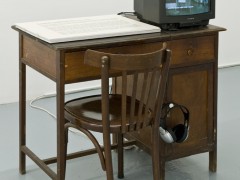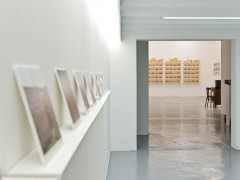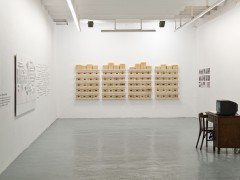Adrian Melis: New Structures of Production
March 3 – May 12, 2012
ADN Galeria, Barcelona
ADN Galeria will open Nuevas estructuras de producción (New structures of production), the first solo show of Adrian Melis at the gallery.
The work of Adrian Melis questions the relationship between a framework constituted by sociopolitical, legal or economical structures and the strategies invented by individuals in order to elude or undermine such strict norms. Directly influenced by the conditions of life in Cuba and his own experience as a voluntary expatriate in Spain, the artist explores the tension between different regimes of productivity and unproductiveness, presence and absence, planning and working force.
At ADN, Adrian Melis presents a selection of projects which documents the failures of the system while playing with them; he proposes alternative models of productivity and gives space to a sort of “creative pragmatism”, which directly emanates from the subjects’ proper environment. Melis calls attention to the existence of a set of parallel activities which functioning relies on tacit agreements and general permissiveness. Such activities interfere with the imposed regime and threaten its apparent structural efficiency.
Introducing the exhibition, the installation Importaciones, lote Nº 1 (Importations, batch Nº1) considers the rules governing the importation of products into the Republic of Cuba. The introduction of certain typologies of commodities, especially computing hardware, is prohibited by the law. In reaction to this official decree, Melis proposes to break technological artifacts into pieces, so they can be removed from the category of functional objects and enter easily the country. In the gallery, a container collects some objects the artist will dismember during the exhibition time. Each separate component will be identified and sent to Cuba thanks to the complicity of people that will carry them into the country.
The photographs from the series Stock display another documentary approach to illegal activities. They document the theft of material from under-construction buildings or warehouses. Each image is completed with a note that specifies the quantity and typology of the subtracted material. The words replace what is absent, restituting what has disappeared and reintroducing the indexical condition of the photographic images. A similar principle guides the installation 378.890m2 proyectados (378.890sqm planned), which point of departure is the activity of Cuban companies that produce materials for construction. Noticing the discrepancy between the companies’ planned productivity and their true balance, Melis calculated the difference between the prognostics and the real results and virtually used the unproduced quantities to elaborate a model of what could have been built if the production plans had been respected.
Unproductiveness and the improper use of working time are at the core of the projects Plan de producción de sueños para las empresas estatales en Cuba (Production plan of dreams for state-run companies in Cuba) and El valor de la ausencia (The value of absence). In the first one, the artist focuses on companies that are part of what he designates as “the areas that are most vulnerable to improductivity”. The workers received a notebook from Melis with the instruction to record the dreams they have during their working day, when they fell asleep on the post. In opposition with their unaccomplished official job, the dreams become a psychic production, an active time at the service of another employer: the artist himself – even if here, the contribution is not paid. The written narratives are exhibited into wooden boxes that evoke a manufactured product, ready to be sold. They are shown together with a series of photographs documenting the project and its actors.
El valor de la ausencia deals with another type of evasion from work: the one that consists of the invention of excuses to avoid going to work. For this service – inventing an excuse and formulating it by phone -, Melis paid the workers with an amount of money which is proportional to the amount deduced from their wage by the employer, because of their absence. Here again, the will to escape from work generates a creative answer. The printed and filmed archives of these phone excuses can be consulted in a desk that recalls the typical furniture of offices.
Finally, two videos complement the exhibition. Aquí todo el mundo me cuida (Everybody takes care of me here) features an interview realized with hidden camera with the director of a company who suffers schizophrenia. This pathology allows him to justify his permissive behavior toward his employees’ illicit activities. Melis’ last video work, Momentos que marcaron el mundo (World´s significant moments) juxtaposes the fixed shot of a street in La Habana at the present and the audio archive from the CNN live broadcasting the fall of the Berlin wall, in 1989. This simple disjunction between image and sound suggests the persistence of an ideological system which already fell apart in certain parts of the world, but still conditions life in Cuba.
Practical Information
ADN Galeria – c/ Enrique Granados, 49, SP-08008 Barcelona
T. (+34) 93 451 0064, info@adngaleria.com
www.adngaleria.com


 Home
Home
